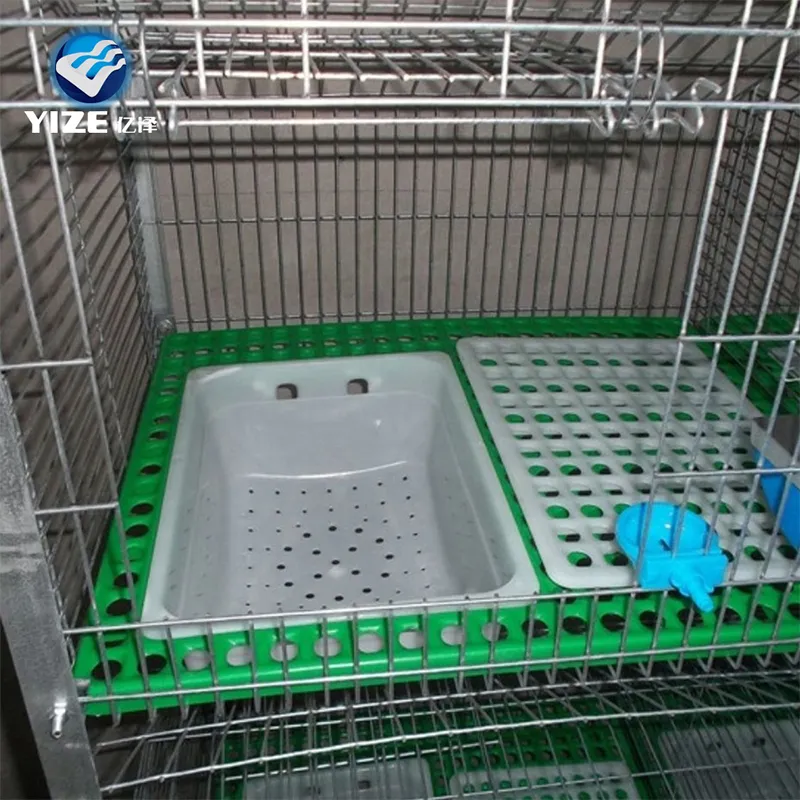When to Replace Your Rabbit Cage
Jul . 17, 2025 16:44 Back to list
When to Replace Your Rabbit Cage
A metal rabbit cage is designed for durability, but over time, even the strongest materials can show signs of wear. Rust is one of the most critical indicators. If you notice reddish-brown spots or flaking on the cage’s surface, it’s a clear signal that the structural integrity is compromised. Rust not only weakens the metal but can also harm your rabbit if ingested during grooming. Additionally, bent or warped bars are a safety hazard. Rabbits are curious creatures and may attempt to squeeze through gaps, risking injury or escape. For stackable rabbit cages, wear on the connectors or hinges can destabilize the entire setup, posing a collapse risk. Regularly inspect joints and latches—if they no longer align properly or feel loose, replacement is urgent.

Another subtle sign of wear is fading or chipping paint. While cosmetic, peeling paint can expose sharp edges or toxic coatings, especially in older cages. Modern metal rabbit cages from reputable manufacturers like Anping County Yize Metal Products Co., Ltd. use non-toxic, powder-coated finishes to ensure safety. If your cage lacks this feature, consider upgrading to a newer model. Lastly, worn flooring grids can cause discomfort. Rabbits’ feet are sensitive, and uneven or broken wire floors may lead to sore hocks, a painful condition. Replace the cage if the floor shows significant sagging or sharp protrusions.
Structural Damage in Stacking Rabbit Cages
Stacking rabbit cages optimize space, but their design demands rigorous stability. If the cage’s frame shows cracks or splits, especially at load-bearing points, immediate replacement is necessary. A compromised frame can collapse under weight, endangering both pets and handlers. For multi-tier setups, check the legs and crossbars for bending or corrosion. Even minor distortions can escalate into major failures.
Doors and latches are frequent failure points. A misaligned door that doesn’t close securely allows escapes or predator access. Similarly, broken latches render the cage insecure. For stackable rabbit cages, ensure interlocking mechanisms remain snug. If cages wobble when stacked or refuse to lock into place, the system is no longer safe. Additionally, inspect mesh panels for gaps or tears. Rabbits may chew on damaged wire, leading to dental issues or intestinal blockages. Anping County Yize Metal Products Co., Ltd. employs reinforced welding techniques to prevent such vulnerabilities, but older cages may lack these advancements.
Hygiene Challenges in Non-Stackable vs. Stackable Rabbit Cages
Hygiene is paramount in rabbit care, and cage design plays a pivotal role. Traditional non-stackable cages often accumulate waste in hard-to-reach corners, fostering bacterial growth. Conversely, modern stackable rabbit cages feature removable trays and smooth surfaces for easier cleaning. If your current cage has porous materials or complex crevices that trap moisture and debris, it becomes a breeding ground for pathogens. Persistent odors despite thorough cleaning indicate ingrained contamination, necessitating a replacement.
Rust-prone or corroded areas in metal rabbit cages are particularly problematic. These spots harbor bacteria and resist sanitization. If scrubbing fails to restore a clean surface, the cage is no longer hygienic. For breeders or multi-rabbit households, stacking rabbit cages with poor ventilation exacerbate respiratory issues. Condensation buildup or mold growth in enclosed spaces signals inadequate airflow—a flaw addressed in newer designs with strategic mesh placement and elevated bases.
Upgrading to Modern Stackable Rabbit Cages
Advancements in cage technology offer compelling reasons to upgrade. Anping County Yize Metal Products Co., Ltd.’s stackable rabbit cages incorporate modular designs, allowing customization as your needs evolve. For instance, adding tiers or accessories like hay feeders becomes seamless. Older cages lacking compatibility with modern accessories limit functionality. Additionally, newer models prioritize ergonomics—smooth edges, easy-access doors, and lightweight yet sturdy materials reduce caregiver strain.
Environmental sustainability is another consideration. Older cages often use materials that degrade poorly, whereas contemporary options employ recyclable metals and eco-friendly coatings. Upgrading not only benefits your rabbits but aligns with global sustainability trends. Finally, improved safety features like anti-chew guards or reinforced flooring in modern metal rabbit cages provide peace of mind, especially for energetic or large breeds.
FAQs: Rabbit Cage Replacement
How do I know if my metal rabbit cage is unsafe?
Look for rust, bent bars, or loose connectors. If the cage wobbles, has sharp edges, or doors that won’t close properly, it’s time for a replacement.
Can stackable rabbit cages be repaired instead of replaced?
Minor issues like loose screws can be fixed, but structural damage (cracked frames, corroded joints) usually requires replacement to ensure safety.
What makes metal rabbit cages more hygienic?
High-quality metal resists moisture and bacteria. Non-porous surfaces and removable trays in stackable designs simplify cleaning.
Are stacking rabbit cages suitable for outdoor use?
Yes, but choose powder-coated, weather-resistant models. Regularly check for rust and ensure the cage is sheltered from extreme elements.
How often should I inspect my rabbit cage?
Conduct a thorough monthly inspection. Daily checks for visible damage or hygiene issues are also recommended.
Anping County Yize Metal Products Co., Ltd. has pioneered durable, hygienic rabbit cages since 1999. Explore our range of stackable rabbit cages and metal rabbit cages designed for longevity and ease of maintenance. Visit our website to invest in a safer, cleaner home for your rabbits—because they deserve nothing less.
-
Evisceration Table - Hygienic, Stainless Steel, Easy-Clean
NewsNov.17,2025
-
Chicken Plucker and Scalder | Fast, Stainless, Adjustable
NewsNov.17,2025
-
Silo Solutions: Durable, Automated, Batching-Ready Storage
NewsNov.17,2025
-
Automatic Drinking Line for Poultry | Precise & Durable
NewsNov.17,2025
-
Cutting Machine for Meat & Bone | High-Precision, Safe
NewsNov.17,2025
-
Chicken Feet Peeling Machine | Fast, Hygienic, High-Yield
NewsNov.10,2025






